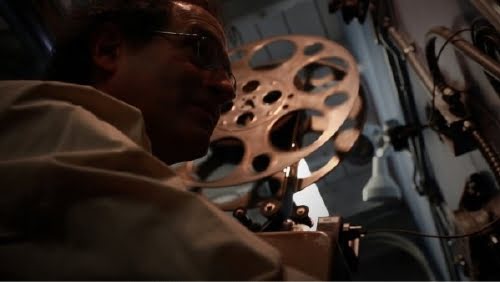The Dying of the Light

For over one hundred years, the guys in the booth at the back of the theater projected the images of the movies that we all so love. But now, digital projection is fast replacing the old photochemical machines and the guys in the booth are a fast disappearing breed. Documentarian Peter Flynn shows us their many faces and tells their stories in “The Dying of the Light.”
Laura's Review: A-
Projectionists were once the 'men behind the curtain,' the technicians who wove photochemical film through a machine that lit and threw its images onto a screen. But digital technology has made these men and women a dying breed. A few still stand in witness to "The Dying of the Light." Writer/director/cinematographer/editor Peter Flynn, a Senior Scholar in residence at Emerson College and the founder of the Boston Irish Film Festival, has made not only an elegy to the romance of the projection booth, but to the cinema experience of yore when movie palaces packed in thousands. Using the Somerville Theater's David Kornfeld as guide/historian, Flynn visits with projectionists of every stripe, from the geeky to the intellectual to the blue collar. Some embrace the fact that in being forced to learn digital projection, they've remade themselves while others, unable to grasp new technology, are forced into retirement. The film is at turns funny, nostalgic and melancholy and will be endlessly fascinating to cinema buffs. Raber Umphenour, one of the younger projectionists, explains how darkness is essential to projecting light. He will later visit an abandoned booth, describing it as a sarcophagus. As Umphenour points out the writings on the wall left by those who once occupied the space, Flynn cuts to photographs of the men who often gave up social lives to man the booth. The jauntily attired Kornfeld makes an intriguing observation while visiting an old drive-in, noting that both sound and picture quality were degraded for the convenience of the suburbanites who frequented them, just as digital is often faulted now for its inferior but more cost effective picture. (We're shown reels, including the massive 70 mm reels necessary for the recent release of "The Hateful Eight," and asked to consider their shipping weight.) Boston Light and Sound's Larry Shaw marvels at the old projectors rescued for The Weinstein Company's roadshow for Tarantino's film, built not only for functionality but beauty of design. But it is all the projectionists and their stories that are at the heart of this film. The Brattle's Dave Leamon explains how the theater used mirrors for rear projection. One of two female projectionists featured, the enthusiastic cinephile Dorman Bermingham, relates how she interned at porn houses. The Northfield Drive-In's Paul Bader once drew a gun on patrons throwing firecrackers into his booth. While automatic reel change-overs decreased the amount of work necessary to run a film, Emerson College's Herb Nipson realized he still walked 28 miles a day running a 19 screen theater. An older projectionist paired with his younger intern are like a comedy team, even as we recognize there will be no more experts left to train a new generation. Flynn and his subjects spend little time contrasting film with digital (look to "Side by Side" for that). Instead he reveals the people least considered by the movie-going public who had a tactile relationship to film. "The Dying of the Light" is the "Cinema Paradiso" of documentaries. Grade:

